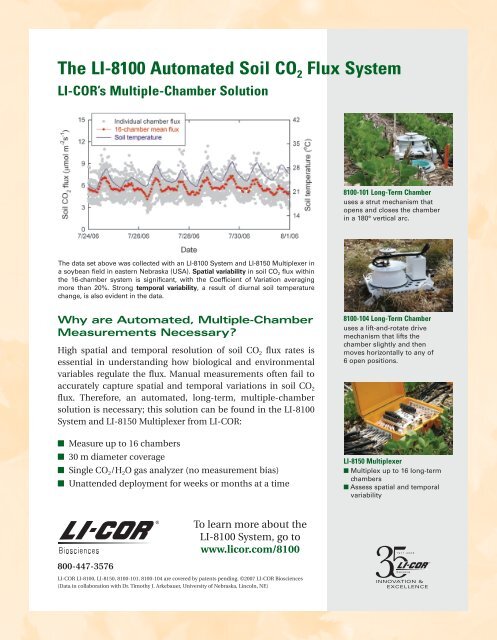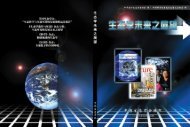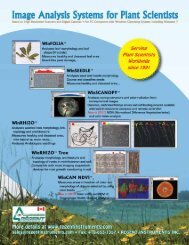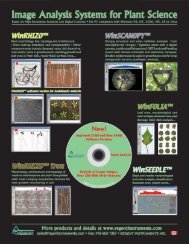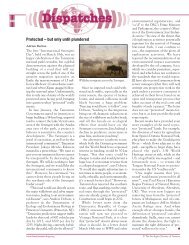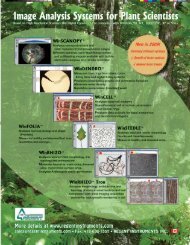The LI-8100 Automated Soil CO2 Flux System - Frontiers in Ecology ...
The LI-8100 Automated Soil CO2 Flux System - Frontiers in Ecology ...
The LI-8100 Automated Soil CO2 Flux System - Frontiers in Ecology ...
Create successful ePaper yourself
Turn your PDF publications into a flip-book with our unique Google optimized e-Paper software.
<strong>The</strong> <strong>LI</strong>-<strong>8100</strong> <strong>Automated</strong> <strong>Soil</strong> CO 2 <strong>Flux</strong> <strong>System</strong><br />
<strong>LI</strong>-COR’s Multiple-Chamber Solution<br />
<strong>8100</strong>-101 Long-Term Chamber<br />
uses a strut mechanism that<br />
opens and closes the chamber<br />
<strong>in</strong> a 180° vertical arc.<br />
<strong>The</strong> data set above was collected with an <strong>LI</strong>-<strong>8100</strong> <strong>System</strong> and <strong>LI</strong>-8150 Multiplexer <strong>in</strong><br />
a soybean field <strong>in</strong> eastern Nebraska (USA). Spatial variability <strong>in</strong> soil CO 2 flux with<strong>in</strong><br />
the 16-chamber system is significant, with the Coefficient of Variation averag<strong>in</strong>g<br />
more than 20%. Strong temporal variability, a result of diurnal soil temperature<br />
change, is also evident <strong>in</strong> the data.<br />
Why are <strong>Automated</strong>, Multiple-Chamber<br />
Measurements Necessary?<br />
High spatial and temporal resolution of soil CO 2 flux rates is<br />
essential <strong>in</strong> understand<strong>in</strong>g how biological and environmental<br />
variables regulate the flux. Manual measurements often fail to<br />
accurately capture spatial and temporal variations <strong>in</strong> soil CO 2<br />
flux. <strong>The</strong>refore, an automated, long-term, multiple-chamber<br />
solution is necessary; this solution can be found <strong>in</strong> the <strong>LI</strong>-<strong>8100</strong><br />
<strong>System</strong> and <strong>LI</strong>-8150 Multiplexer from <strong>LI</strong>-COR:<br />
■ Measure up to 16 chambers<br />
■ 30 m diameter coverage<br />
■ S<strong>in</strong>gle CO 2 /H 2 O gas analyzer (no measurement bias)<br />
■ Unattended deployment for weeks or months at a time<br />
<strong>8100</strong>-104 Long-Term Chamber<br />
uses a lift-and-rotate drive<br />
mechanism that lifts the<br />
chamber slightly and then<br />
moves horizontally to any of<br />
6 open positions.<br />
<strong>LI</strong>-8150 Multiplexer<br />
■ Multiplex up to 16 long-term<br />
chambers<br />
■ Assess spatial and temporal<br />
variability<br />
800-447-3576<br />
To learn more about the<br />
<strong>LI</strong>-<strong>8100</strong> <strong>System</strong>, go to<br />
www.licor.com/<strong>8100</strong><br />
<strong>LI</strong>-COR <strong>LI</strong>-<strong>8100</strong>, <strong>LI</strong>-8150, <strong>8100</strong>-101, <strong>8100</strong>-104 are covered by patents pend<strong>in</strong>g. ©2007 <strong>LI</strong>-COR Biosciences<br />
(Data <strong>in</strong> collaboration with Dr. Timothy J. Arkebauer, University of Nebraska, L<strong>in</strong>coln, NE)
“<strong>The</strong> Deep is not only the most stunn<strong>in</strong>gly beautiful book about the sea<br />
ever produced, but also a work of scientific substance, articulated by some<br />
of the best, most experienced deep-sea scientists of our time.”<br />
—Sylvia Earle, National Geographic Society<br />
<br />
For more <strong>in</strong>formation and color photos from <strong>The</strong> Deep,<br />
go to www.thedeepbook.org.<br />
<br />
<br />
<br />
<br />
“I know of no other work that provides such a comprehensive review<br />
of the history of deep-sea exploration. <strong>The</strong> Silent Deep will be readily<br />
understood and appreciated by the general reader.”—Richard Lutz,<br />
Rutgers University<br />
<br />
<br />
<br />
Oceans collects more than thirty articles from the past decade of<br />
Scientific American, <strong>in</strong>clud<strong>in</strong>g recent pieces written <strong>in</strong> the wake of the<br />
2004 tsunami. <strong>The</strong> book features articles that <strong>in</strong>vestigate the orig<strong>in</strong>s of<br />
the world’s oceans, the diversity of life <strong>in</strong> the water, the state of global<br />
fisheries, the dangers of natural disasters, and the impr<strong>in</strong>ts of humans<br />
on this fragile frontier.<br />
<br />
Ethical Issues <strong>in</strong> <strong>Ecology</strong>: Case studies is a must for<br />
stimulat<strong>in</strong>g lively discussions <strong>in</strong> a variety of educational<br />
sett<strong>in</strong>gs, <strong>in</strong>clud<strong>in</strong>g college classrooms, workshops and<br />
courses, lab group meet<strong>in</strong>gs, and <strong>in</strong>-house sem<strong>in</strong>ars.<br />
Jeff Dudycha and Kev<strong>in</strong> Geedey present a series of<br />
thought-provok<strong>in</strong>g fictional scenarios to highlight the<br />
ethical dilemmas faced by ecologists and other research<br />
scientists today. L<strong>in</strong>ked commentaries give general<br />
guidance to group leaders and teachers, help<strong>in</strong>g them to<br />
avoid common pitfalls and to keep the discussion mov<strong>in</strong>g.<br />
Based on the highly popular Ethical Issues series <strong>in</strong><br />
ESA’s journal <strong>Frontiers</strong> <strong>in</strong> <strong>Ecology</strong> and the<br />
Environment, this readable <strong>in</strong>troduction to ethical<br />
debate can be used by anyone – no formal tra<strong>in</strong><strong>in</strong>g <strong>in</strong><br />
ethics required.<br />
“Ultimately, the ecologist’s toolkit needs to <strong>in</strong>clude<br />
methods for deal<strong>in</strong>g with ethical issues”<br />
– From the Introduction by Carol Brewer<br />
Order onl<strong>in</strong>e today at www.esa.org.<br />
$12.00<br />
esa<br />
Promot<strong>in</strong>g the Science of <strong>Ecology</strong>
2007<br />
Tyler Prize<br />
Gatze Lett<strong>in</strong>ga<br />
Emeritus Professor<br />
Wagen<strong>in</strong>gen University<br />
Sub-department of Environmental Technology<br />
Wagen<strong>in</strong>gen, <strong>The</strong> Netherlands<br />
<strong>The</strong> Tyler Prize was established <strong>in</strong> 1973 by the late John and<br />
Alice Tyler as an <strong>in</strong>ternational award honor<strong>in</strong>g achievements<br />
<strong>in</strong> environmental science, policy, energy and health of<br />
worldwide importance conferr<strong>in</strong>g great benefit on humanity.<br />
<strong>The</strong> Tyler Prize consists of a cash award of $200,000 and a<br />
gold Tyler Prize medallion.<br />
<strong>The</strong> Tyler Prize Executive Committee announces the award<strong>in</strong>g<br />
of the 2007 Tyler Prize for Environmental Achievement on its<br />
thirty-fourth anniversary to Prof. Dr. Ir. Gatze Lett<strong>in</strong>ga, Wagen<strong>in</strong>gen<br />
University, <strong>The</strong> Netherlands.<br />
Gatze Lett<strong>in</strong>ga is recognized for his research and development of<br />
an environmentally sound novel process for the treatment of<br />
polluted wastewater and its implementation worldwide, especially<br />
<strong>in</strong> develop<strong>in</strong>g countries. Web: www.uasb.org/discover/agsb.htm<br />
Recent Laureates<br />
2000 John Holdren, for Energy & Public Policy<br />
2001 Jared Diamond and Thomas E. Lovejoy, for Conservation Biology<br />
2002 Wallace S. Broecker, for Ocean Chemistry and Tungsheng Liu, for Paleoclimatology<br />
2003 Sir Richard Doll, Hans Herren and Yoel Margalith, for Environmental Medic<strong>in</strong>e and Public Health<br />
2004<strong>The</strong> Barefoot College and Red Lat<strong>in</strong>oamericana de Botánica (RLB), for Environmental Education<br />
2005 Charles David Keel<strong>in</strong>g and Lonnie G. Thompson, for Atmospheric Chemistry and<br />
Glaciology related to Climate Change<br />
2006 David W. Sch<strong>in</strong>dler and Igor A. Shiklomanov, for Natural and Human Impacts on Freshwater Resources<br />
For additional <strong>in</strong>formation and nom<strong>in</strong>ations contact:<br />
Dr. L<strong>in</strong>da E. Duguay, Executive Director, <strong>The</strong> Tyler Prize<br />
Phone (213) 740-9760, Fax (213) 740-1313<br />
Email: tylerprz@usc.edu<br />
Home page www.usc.edu/tylerprize<br />
<strong>The</strong> Tyler Prize is adm<strong>in</strong>istered by<br />
<strong>The</strong> University of Southern California<br />
Members of the Tyler Prize Executive Committee<br />
Dr. Owen T. L<strong>in</strong>d, Chair, Baylor University<br />
Dr. Ros<strong>in</strong>a M. Bierbaum, University of Michigan<br />
Dr. Robert A. Frosch, Harvard University and Woods Hole<br />
Oceanographic Institution<br />
Dr. Arturo Gómez-Pompa, University of California, Riverside<br />
and Universidad Veracruzana<br />
Dr. Judith E. McDowell, Woods Hole Oceanographic Institution<br />
Dr. Ralph Mitchell, Harvard University<br />
Dr. F. Sherwood Rowland, University of California, Irv<strong>in</strong>e<br />
Dr. Jonathan M. Samet, <strong>The</strong> Johns Hopk<strong>in</strong>s University<br />
Dr. Cornelius W. Sullivan, University of Southern California<br />
<strong>The</strong> perfect graduation gift<br />
could be right <strong>in</strong> your hands<br />
When you give the gift of an ESA membership, you give the<br />
ecology and environmental sciences graduates <strong>in</strong> your life<br />
the resources they need to succeed:<br />
■ Timely, <strong>in</strong>formative articles <strong>in</strong> the latest issues of <strong>Frontiers</strong>, plus access to the full<br />
onl<strong>in</strong>e archive<br />
<strong>Frontiers</strong> <strong>in</strong><strong>Ecology</strong><br />
T H E E C O L O G I C A L S O C I E T Y O F A M E R I C A<br />
and the Environment<br />
Issue No 1 Volume 5 February 2007<br />
Ecological genomics <strong>in</strong> the field<br />
Invertebrate biomonitor<strong>in</strong>g <strong>in</strong> East Asia<br />
Forest degradation <strong>in</strong> the Amazon Bas<strong>in</strong><br />
esa<br />
<strong>Frontiers</strong> <strong>in</strong><strong>Ecology</strong><br />
T H E E C O L O G I C A L S O C I E T Y O F A M E R I C A<br />
and the Environment<br />
Issue No 2 Volume 5 March 2007<br />
■ Over 9,800 contacts work<strong>in</strong>g <strong>in</strong> ecology and environmental sciences<br />
■ First looks at job and grant opportunities<br />
Animal cultures <strong>in</strong> fragmented landscapes<br />
■ A voice <strong>in</strong> the development and promotion of the science and profession of ecology<br />
■ And much, much more.<br />
<strong>The</strong> legacy of Smokey Bear<br />
<strong>Frontiers</strong> <strong>in</strong><strong>Ecology</strong><br />
T H E E C O L O G I C A L S O C I E T Y O F A M E R I C A<br />
Nitrate removal <strong>in</strong> aquatic ecosystems<br />
esa<br />
and the Environment<br />
Issue No 3 Volume 5 April 2007<br />
Give an ESA membership and make an <strong>in</strong>vestment <strong>in</strong> the future of ecology today.<br />
esa<br />
Contact membership@esa.org or 202-833-8773 ext. 216<br />
with questions.<br />
Conservation easements <strong>in</strong> context<br />
Protected area needs <strong>in</strong> a chang<strong>in</strong>g climate<br />
Key gaps <strong>in</strong> population and community ecology<br />
esa<br />
Sign up before the end of the school year to take advantage of student member rates.
SAVE THE DATE<br />
ESA/SER Jo<strong>in</strong>t Meet<strong>in</strong>g<br />
August 5–10, 2007<br />
San José, California<br />
<strong>The</strong>me: Ecological restoration<br />
<strong>in</strong> a chang<strong>in</strong>g world<br />
Sampl<strong>in</strong>g of Special Sessions, Symposia, Organized Oral Sessions,<br />
and Workshops<br />
Special Sessions:<br />
• SS 1 International Connections: Advantages, Opportunities, and Challenges to<br />
International Research <strong>in</strong> <strong>Ecology</strong>.<br />
• SS 2 Decadal Science Plann<strong>in</strong>g for the Ecological Sciences<br />
• SS 3 What is NEON becom<strong>in</strong>g?<br />
• SS 4 Informational session: Opportunities for Fund<strong>in</strong>g <strong>in</strong> Environmental Biology<br />
and Related Areas at NSF<br />
Symposia:<br />
• SYMP 1 Ecological Constra<strong>in</strong>ts to the Restoration of California Grasslands<br />
• SYMP 2 Tipp<strong>in</strong>g Po<strong>in</strong>ts <strong>in</strong> the Biosphere: Agriculture, Water, and Resilience<br />
• SYMP 3 Key Concepts and Research Questions <strong>in</strong> Restoration <strong>Ecology</strong><br />
• SYMP 4 Flexible Foragers <strong>in</strong> Food Webs<br />
Organized Oral Sessions:<br />
• OOS 1 Host-associated Differentiation <strong>in</strong> Multi-trophic Interactions: Host Plants<br />
as Ecological and Evolutionary Islands<br />
• OOS 2 Forest Restoration at the Scale of the Landscape<br />
• OOS 3 Restoration of Western Riparian Ecosystems: Challenges and Solutions<br />
• OOS 4 Diagnostic Assessment: Uncover<strong>in</strong>g and Respond<strong>in</strong>g to How our<br />
Students are Th<strong>in</strong>k<strong>in</strong>g<br />
Workshops:<br />
• WK 1 Explor<strong>in</strong>g Pathways Toward Restor<strong>in</strong>g Agroecosystem Internal Control<br />
• WK 2 <strong>The</strong> California Rapid Assessment Method (CRAM): A Tool for Assess<strong>in</strong>g<br />
the Condition of Wetland Restoration Projects<br />
• WK 3 Ecoquest: An Ecological Academic Classroom<br />
• WK 4 Demography and Dispersal: <strong>The</strong> Analysis of Invasion Wave Speeds<br />
Scientific Program Features:<br />
<strong>The</strong> scientific program, chaired by Kerry Woods (ESA) and Bill Halvorson (SER), will <strong>in</strong>clude:<br />
Plenaries • Symposia • Special Sessions • Organized Oral Sessions<br />
Contributed Oral Paper Sessions • Poster Presentations • Workshops<br />
A variety of scientific field trips <strong>in</strong> the San José region are be<strong>in</strong>g arranged by the local host chair,<br />
Rachel O’Malley, and the local host committee.<br />
For more <strong>in</strong>formation about special sessions, organized oral sessions, symposia,<br />
workshops, and more, please visit<br />
http://www.esa.org/sanjose/
CI-600 ROOT SCANNER<br />
FOR ROOT MONITORING<br />
<strong>The</strong> CI-600 Root Scanner is designed to scan<br />
liv<strong>in</strong>g roots <strong>in</strong> the soil. It is operated by a<br />
laptop computer. To obta<strong>in</strong> an image, <strong>in</strong>sert<br />
the scan head <strong>in</strong>to a pre-<strong>in</strong>stalled Plexiglass<br />
tube. <strong>The</strong> scan head will automatically rotate<br />
a full circle, creat<strong>in</strong>g a 21.59 × 19.56 cm highresolution<br />
image of the soil and roots. Users<br />
can move the scan head to different depths,<br />
and move from tube to tube.<br />
A flat scanner model is also now available.<br />
Up to 188 million pixels super highresolution<br />
image.<br />
L<strong>in</strong>ear scann<strong>in</strong>g with no distortion.<br />
Very portable and quick operation.<br />
Zoom <strong>in</strong> to any area of a<br />
scanned image.<br />
Photos courtesy of Dr. Dylan Fischer at Evergreen<br />
State College. For more images please visit his web<br />
site: http://academic.evergreen.edu/f/fischerd/<br />
research/m<strong>in</strong>irhizotron.htm.<br />
www.cid-<strong>in</strong>c.com<br />
CID,Inc.<br />
4845 NW Camas Meadows Dr.• Camas, WA 98607 • USA<br />
Phone: (360) 833-8835 • USA and Canada: (800) 767-0119<br />
Fax: (360) 833-1914 • E-mail: sales@cid-<strong>in</strong>c.com


